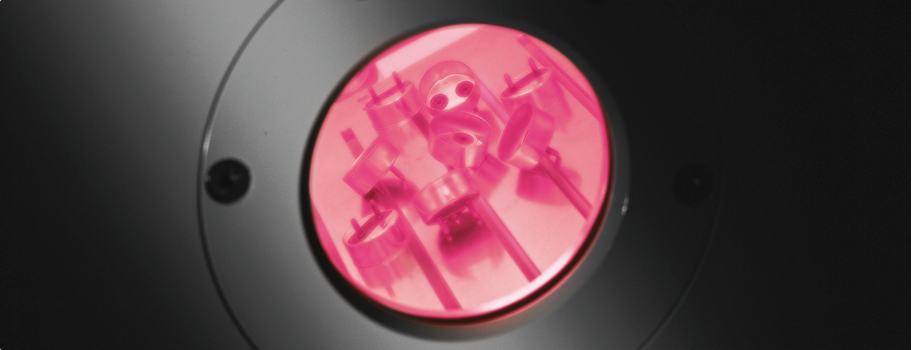The efficient method for best results

Wide range of application
Low-pressure plasma is produced by electromagnetic fields. The induced chemical reactions and physical effects depend on the respective gas and excitation frequency used for plasma formation.
The used gas, for instance, determines if the respective plasma is an oxidizing or reducing medium or neither of them (neutral).

Neutral plasmas
Neutral plasma forms e.g. if a noble gas like argon is used. The major effect of neutral plasma is physical: Contaminants are removed by a bombardment with heavy ions (sputtering). Low excitation frequencies (kHz range) will boost this effect significantly as ions will gain much more velocity before they impact onto the surface. As fast and heavy ions transfer heat to the surfaces they collide with, this method is limited to suitable materials and surfaces.

Reactive plasmas
Reactive plasmas are formed from gases like oxygen, hydrogen or fluorocarbons. The oxidizing, reducing or functionalizing effects originate from the ions and radicals present in plasma which readily react with the substrate material or the topping contaminant. After plasma treatment, surfaces are activated, passivated or particularly clean, respectively.
An especially high excitation frequency (GHz) promotes such reactions as it results in a high ion density in the plasma phase and therefore maximizes reactivity. Simultaneously, ion energies remain low, so sputter effects and heat load are minimized or not incurred at all.

Eco-friendly and efficient
Such procedures of the low-pressure plasma technology are not only extremely efficient, but also ecologically neutral and economically useful because usually no polluting waste products and no disposal costs incur therefore.
Exemplary low-pressure plasma treatment effects
- Removal of organic residues
- Activation by means of oxidation of polymer chains
- Coating by means of polymerisation of suitable monomers
- Removal of disturbing oxide layers by reduction
- Etching by the use of aggressive gases and reaction conditions
Varying process gases and excitation frequencies, there is a broad selection of possible plasma effects. Verification of the desired plasma effect on the actual substrate should never be skipped as thorough process development may be necessary. PINK warrants its developed processes and therefore safeguards customer’s investments in PINK equipment.
Compare systems
|
Type |
V6-G | V10-G | V15-G | V55-G | V80-G-Side |
| Type of system | Tabletop unit | Tabletop unit | 19" cabinet | 19" cabinet | 19" cabinet |
| Dimensions of the chamber (W x D x H) [mm] |
170 x 200 x 170 | Ø215 x 260 | 250 x 250 x 250 | 400 x 460 x 340 | 400 x 500 x 430 |
| Microwave power [W] |
50-300 | 50-600 | 100-600 | 100-1,200 | 100-1,200 |
| Gas inlets with mass flow control | 1 | 1 | 1 | 2 | 2 |
| Power supply | 230 V, 50/60 Hz | 230 V, 50/60 Hz | 230 V, 50/60 Hz | 230 V, 50/60 Hz | 230 V, 50/60 Hz |
| Power input (without pump) [kVA] |
0.5 | 1.5 | 1.5 | 2.2 | 2.2 |
| Dimensions of the system (W x D x H) [mm] |
640 x 710 x 710 | 720 x 820 x 820 | 670 x 900 x 1,850 | 670 x 900 x 1,850 | 850 x 900 x 1,850 |
|
Options |
|||||
| Additional gas inlets | 2 | 2 | 3 | 2 | 2 |
| Additional excitation frequencies (40 kHz, 13.56 MHz) |
- | - |  |
 |
 |
| Soft start/slow vent |  |
 |
 |
 |
 |
| Lateral microwave feed-in |  |
- |  |
- |  |
| Rotary table | - | - |  |
 |
 |
| Rotary drum |  |
- |  |
 |
 |
| Pullout door | - |  |
- |  |
 |
| Automatic door opening | - | - | - |  |
 |





